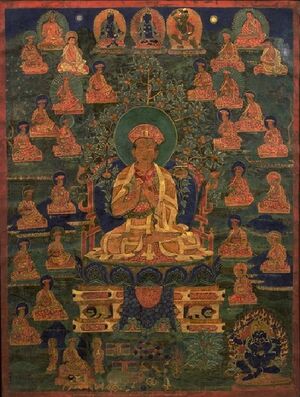Pema Karpo's Treasure Vault of Mahāmudrā[edit]
Pema Karpo is perhaps the most well-known scholar of the Drukpa Kagyu tradition and undoubtedly the leading systemizer of the Mahāmudrā system in this tradition. In his famous work entitled An Exposition of Mahāmudrā: The Treasure Vault of the Victors, he presents the Mahāmudrā, particularly the Co-emergent Union (ལྷན་ཅིག་སྐྱེས་སྦྱོར་), in five chapters. In the first chapter on the Mahāmudrā of word or teachings, he discusses the texts and transmissions of Mahāmudrā teachings which primarily deal with the view. They are classified into three sets of (1) explanatory words (བཤད་པ་ཚིག་གི་སྐོར་), (2) practical instructions (གདམས་ངག་ཉམས་ལེན་གྱི་སྐོར་), and (3) blessings for realization (རྟོགས་པ་བྱིན་རླབས་ཀྱི་སྐོར་). He also discusses the concept of oral guidance, explaining who is being guided, what guides them, from where and to where one is guided, and the different types of oral guidance.
Next, in the second chapter, he explains what Mahāmudrā means by carrying out a discussion on the term mudrā, the four different types of mudrās, and how Mahāmudrā is a universal panacea like the Single White Remedy (དཀར་པོ་གཅིག་ཐུབ་). In the third chapter, Pema Karpo explains the Co-emergent Union of Gampopa by categorizing it into (1) the co-emergent nature of the mind (སེམས་ཉིད་ལྷན་ཅིག་སྐྱེས་པ་) and (2) the co-emergent nature of appearance (སྣང་བ་ལྷན་ཅིག་སྐྱེས་པ་), which are dharmakāya and the radiance of dharmakāya respectively. He also cites the different interpretations and understandings of this practice while explaining the four practices of single-pointedness, nonelaboration, single-taste, and nonmeditation.
Pema Karpo starts the fourth chapter on the instructions for Co-emergent Union by discussing the Mahāmudrā of reality and Mahāmudrā of confusion and underscoring that the Co-emergent Union is the innate, primordial, and original awareness, the pristine wisdom of the Buddha, which is naturally pure, unconditioned, nondual, stainless, and ineffable, being beyond the realm of conceptual thought and language. In the course of this discussion, he goes on to refute the position held by the Jonangpas that buddha-nature is absolute reality which is totally different from the appearance of ordinary existence. The Jonangpas assert that while buddha-nature, which is the primordially pure ultimate truth, transcends dependent origination, the ordinary phenomena, which is the impure conventional truth, is characterized by conditioned existence through dependent origination. Pema Karpo refutes the Jonangpa position using various scriptural citations and reasoning. He goes on to argue that even nirvāṇa is relative to saṃsāra and therefore devoid of absolute self-existence. In the final chapter, Pema Karpo undertakes a detailed rebuttal of Sakya Paṇḍita's criticism of Mahāmudrā in his Distinguishing the Three Vows.
Weekly quote[edit]
~

